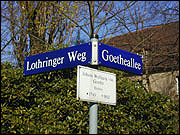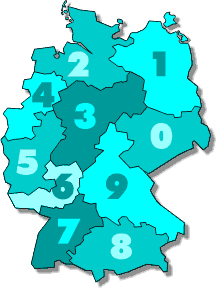11.14 Addresses and postcodes
On the following three pages you will find a basic introduction to structuring a German letter. The German Department of the University of Exeter has developed a web-site on how to write a German letter and this can be accessed by clicking here:
The address (die Adresse)
German addresses are much shorter than British addresses. Whereas British addresses can extend to six or seven lines with their house names, villages, town and counties, addresses in German-speaking countries tend to contain only three lines - the name of the addressee, the street name and number and the town/city together with the post code. Other differences include:
- German street numbers occur after the name of the street and not before - e.g. Hauptstraße 43, Wolburgsweg 36c, Webergasse 7-9.
- Postcodes in German-speaking countries precede the name of the town or city - e.g. 10825 Berlin, 09117 Chemnitz, 01069 Dresden.
Street names (der Straßenname)
German street names are usually one or two words long, depending on the nature of the first element of the name. Whereas streets named after people tend to written as one word - e.g. Schillerstraße, Brahmsweg -, cities and regions that appear in street names are for example usually written as a separate word - e.g. Berliner Straße, Frankfurter Allee, Leipziger Platz.
The signpost below bears this out. Lothringer Weg is written as two words as it is named after the German word for the region of Lorraine (= Lothringen). Goetheallee on the other hand is written as one word as it celebrates Germany's most famous writer Johann Wolfgang von Goethe (1749-1832).
 |
| A German signpost |
|
The second element of a German street name is normally a type of thoroughfare as listed in the table below:
 Vocabulary 1: Types of German roads Vocabulary 1: Types of German roads |
 |
die Allee (-n)
(avenue) |
|
 |
der Ring (-e)
(ring road) |
 |
die Chaussee (-n)
(avenue; highway) |
|
 |
der Steig (-e)
(path) |
 |
der Damm
(pl. - Dämme)
(road (lit: dam)) |
|
 |
die Straße (-n)
(road; street) |
 |
die Gasse (-n)
(lane; alley) |
|
 |
das Ufer (-)
((river-)bank) |
 |
die Landstraße (-n)
(country road) |
|
 |
der Weg (-e)
(way; road) |
 |
der Pfad (-e)
(path; track) |
|
 |
die Zeile (-n)
(row) |
 |
der Platz (pl. - Plätze)
(square) |
|
Other road names do not contain a type of thoroughfare, but instead describe a landmark in the vicinity of the road - i.e. Am Park, Am Hauptbahnhof, An der Brücke (= bridge).
The postcode (die Postleitzahl)
Germany pioneered the idea of post codes back in the early sixties, and the rest of the world imitated the concept. The German word for a postcode is "die Postleitzahl (-en)", which is often abbreviated to "PLZ".
The current postcode system was introduced on 1 July 1993 to take account of post-reunification Germany. All addresses now have a five-digit code, with the first two numbers indicating the region and the last three narrowing it down to a specific area of a town or a village. Hence the reason why German addresses are so much shorter than British ones - the postcode supplies all the requisite information. Below is a map showing the regions of Germany to which the first number of the post code corresponds.

Unlike British postcodes, German postcodes precede the name of the place in addresses.
In addition, when writing to one of the German-speaking countries from abroad, people sometimes prefix the postcode with the international country code for the sake of clarity. As Germany has the international country code "D", this produces such postcodes as D-10825 Berlin and D-01069 Dresden.
A similar principle applies when writing from overseas to addresses in the other German-speaking countries. Austria has the international country code "A", Switzerland has "CH" and Liechtenstein "FL". As postcodes in these countries have four digits, this produces such postcodes as A-9010 Klagenfurt, CH-4012 Basel or FL-9490 Vaduz.
These international country codes are now however increasingly seen as archaic. The correct convention for addressing international letters is not to prefix the postcode with a country code, but to ensure that the
country name is written in capital letters in the language of the origin country on a line of its own at the end of the address - e.g. "10825 Berlin, Deutschland", "9010 Klagenfurt, Österreich", "4012 Basel, Schweiz", "9490 Vaduz, Liechtenstein".
To find out a postcode for one of the German-speaking countries, consult the following websites and search engines:
 |
Web Links |
 |
| Web sites on German postcodes |
 |
Deutsche Post |
This English-language page on the Deutsche Post website allows you to search for the postcode of a known address. |
 |
PLZdir |
An online search engine for German postcodes. |
 |
Post.at |
The Austrian post office offers an online postcode service for Austria. In English. |
 |
Postleitzahlen.ch |
A simple search engine format allows you to search for postcodes in Switzerland, Austria and Liechtenstein. |
 |
Swiss Post - Postcode Directory |
You can search for a postcode in Switzerland and Liechtenstein on the English-language pages of Swiss Post. |
|
 Chapter 11.15: Ein Brief an ein Hotel Chapter 11.15: Ein Brief an ein Hotel
 Nach oben Nach oben
 Print This Page Print This Page
|